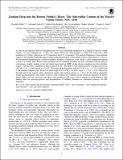Files in this item
Looking deep into the Rosette Nebula's heart : the (sub)stellar content of the massive young cluster NGC 2244
Item metadata
| dc.contributor.author | Muzic, Koraljka | |
| dc.contributor.author | Scholz, Alexander | |
| dc.contributor.author | Pena Ramirez, Karla | |
| dc.contributor.author | Jayawardhana, Ray | |
| dc.contributor.author | Schodel, Rainer | |
| dc.contributor.author | Geers, Vincent C. | |
| dc.contributor.author | Cieza, Lucas A. | |
| dc.contributor.author | Bayos, Amelia | |
| dc.date.accessioned | 2019-09-04T16:30:05Z | |
| dc.date.available | 2019-09-04T16:30:05Z | |
| dc.date.issued | 2019-08-14 | |
| dc.identifier | 261012379 | |
| dc.identifier | dc06da1b-8cf0-4bd4-a665-18dc508f55f9 | |
| dc.identifier | 000481848600008 | |
| dc.identifier | 85072026829 | |
| dc.identifier.citation | Muzic , K , Scholz , A , Pena Ramirez , K , Jayawardhana , R , Schodel , R , Geers , V C , Cieza , L A & Bayos , A 2019 , ' Looking deep into the Rosette Nebula's heart : the (sub)stellar content of the massive young cluster NGC 2244 ' , Astrophysical Journal , vol. 881 , no. 1 , 79 . https://doi.org/10.3847/1538-4357/ab2da4 | en |
| dc.identifier.issn | 0004-637X | |
| dc.identifier.other | BibCode: 2019ApJ...881...79M | |
| dc.identifier.uri | https://hdl.handle.net/10023/18420 | |
| dc.description | A.S.'s work is supported by the STFC grant No. ST/R000824/1. | en |
| dc.description.abstract | As part of the ongoing effort to characterize the low-mass (sub)stellar population in a sample of massive young clusters, we have targeted the ~2 Myr old cluster NGC 2244. The distance to NGC 2244 from Gaia DR2 parallaxes is 1.59 kpc, with errors of 1% (statistical) and 11% (systematic). We used the Flamingos-2 near-infrared camera at the Gemini-South telescope for deep multi-band imaging of the central portion of the cluster (~2.4 pc2). We determined membership in a statistical manner, through a comparison of the cluster's color–magnitude diagram to that of a control field. Masses and extinctions of the candidate members are then calculated with the help of evolutionary models, leading to the first initial mass function (IMF) of the cluster extending into the substellar regime, with the 90% completeness limit around 0.02 M ⊙. The IMF is well represented by a broken power law (dN/dM ∝ M −α ) with a break at ~0.4 M ⊙. The slope on the high-mass side (0.4–7 M ⊙) is α = 2.12 ± 0.08, close to the standard Salpeter slope. In the low-mass range (0.02–0.4 M ⊙), we find a slope α = 1.03 ± 0.02, which is at the high end of the typical values obtained in nearby star-forming regions (α = 0.5–1.0), but still in agreement within the uncertainties. Our results reveal no clear evidence for variations in the formation efficiency of brown dwarfs (BDs) and very low-mass stars due to the presence of OB stars, or for a change in stellar densities. Our finding rules out photoevaporation and fragmentation of infalling filaments as substantial pathways for BD formation. | |
| dc.format.extent | 22 | |
| dc.format.extent | 3968341 | |
| dc.language.iso | eng | |
| dc.relation.ispartof | Astrophysical Journal | en |
| dc.subject | Open clusters and associations: individual (NGC 2244) | en |
| dc.subject | Stars: formation | en |
| dc.subject | Stars: luminosity function, mass function | en |
| dc.subject | Stars: pre-main sequence | en |
| dc.subject | QB Astronomy | en |
| dc.subject | 3rd-DAS | en |
| dc.subject.lcc | QB | en |
| dc.title | Looking deep into the Rosette Nebula's heart : the (sub)stellar content of the massive young cluster NGC 2244 | en |
| dc.type | Journal article | en |
| dc.contributor.sponsor | Science & Technology Facilities Council | en |
| dc.contributor.institution | University of St Andrews. School of Physics and Astronomy | en |
| dc.contributor.institution | University of St Andrews. St Andrews Centre for Exoplanet Science | en |
| dc.identifier.doi | https://doi.org/10.3847/1538-4357/ab2da4 | |
| dc.description.status | Peer reviewed | en |
| dc.identifier.url | http://adsabs.harvard.edu/abs/2019ApJ...881...79M | en |
| dc.identifier.grantnumber | ST/R00824/1 | en |
This item appears in the following Collection(s)
Items in the St Andrews Research Repository are protected by copyright, with all rights reserved, unless otherwise indicated.

